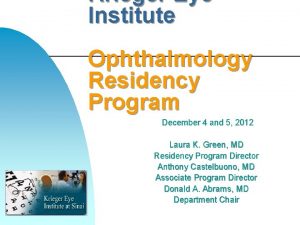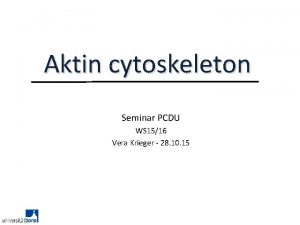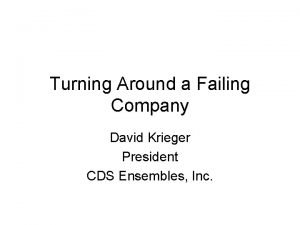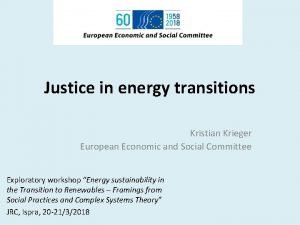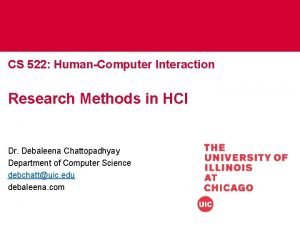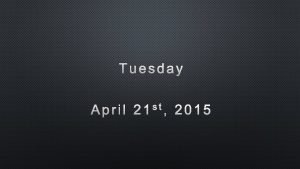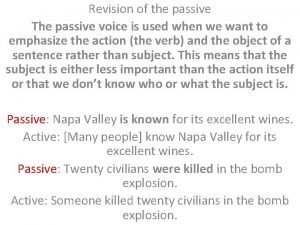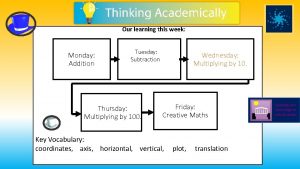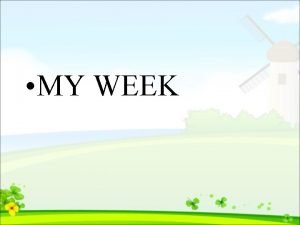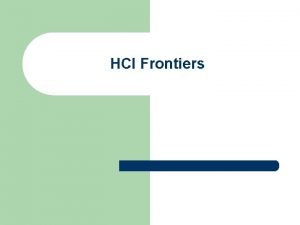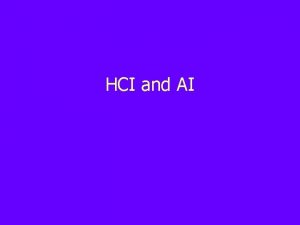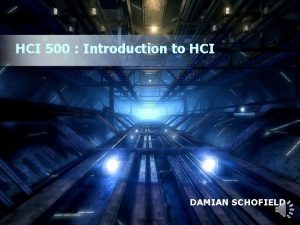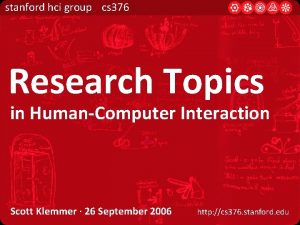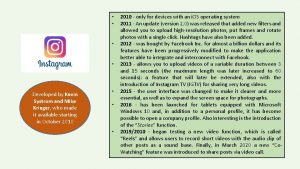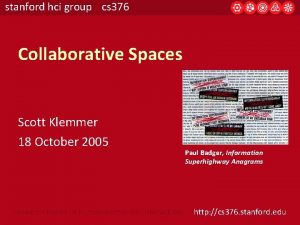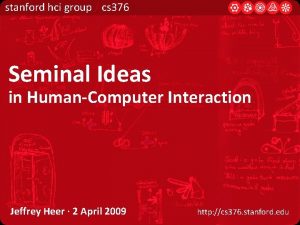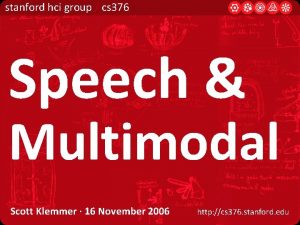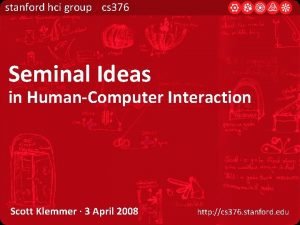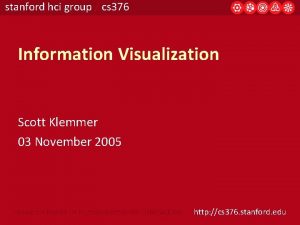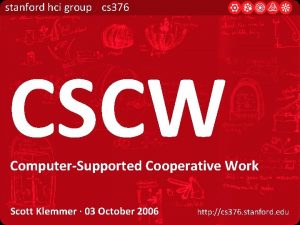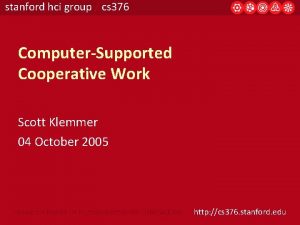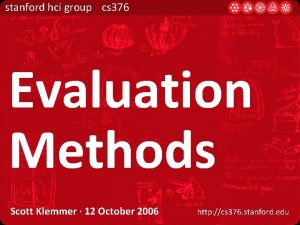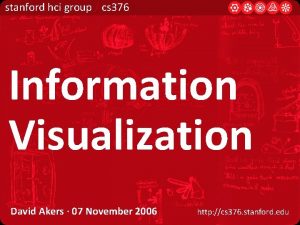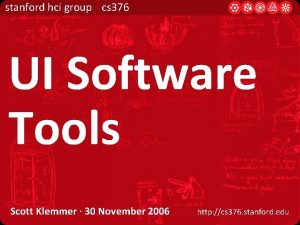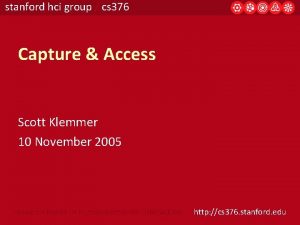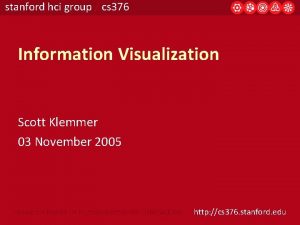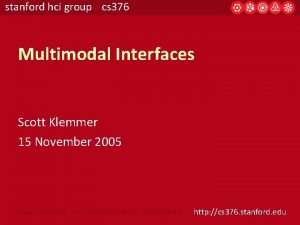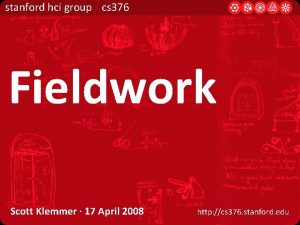Research HCI Mike Krieger CS 376 Tuesday April



























- Slides: 27

Research & HCI Mike Krieger CS 376 Tuesday, April 15 th

Outline • • Why philosophy of science? Kuhn’s view on Revolutions The Sciences of the Artificial Discussion & Activities throughout • Goal of today: Understand different ways of looking at science, looking at design as a science, and applying these ideas to HCI

Keywords from Critiques current design engineering example field human idea knowledge Kuhn natural nature normal paper paradigm people point problem process revolutions science scientific sense Simon solving structure theory think thought time viewing work world

Philosophy of Science • Beyond just a method • Central questions: – What is science, and what is not? – How does scientific progress happen?

Scientific Method 1. Define the question 4. Perform experiment and collect data 7. Publish results 2. Gather information and resources (observe) 3. Form hypothesis 5. Analyze data 6. Interpret data and draw conclusions that serve as a starting point for new hypothesis 8. Retest (frequently done by other scientists) Crawford S, Stucki L (1990)

Philosophical Positions Positivists: Science is that which emerges from the scientific method Popper: Science is that which is falsifiable Polanyi: Knowing is personal, must be transmitted Kuhn: Science is informed by a series of paradigms Feyerabend: Anything goes

Thomas Kuhn • Born 1922, died 1996 • Physicist, later interested in history & philosophy of science • Professor at Berkeley and Princeton

The Structure of Scientific Revolutions • Published in 1962, met with resistance • 30 sec summary: Scientists are informed by the paradigm of their time; most of their work is not focused on confirming the ‘disciplinary matrix’ they work in, but in applying it; odd results are at first explained away, and when they become overwhelming, trigger a scientific revolution; philosophy of science should pay attention to socio/political elements of science. • Why controversial?

Your reactions • Average rating: 4. 11 • It would be interesting to see how Kuhn’s argument holds up across different cultures that don’t share the western way of thinking about science. –Crystal Fong • Being more exposed to the paradigm easily limits one’s thought to the boundary of it. – Jae min John • This piece provided a much-needed perspective on what it means to do research, and what constitutes a scientific revolution. – Steve Marmon

Your reactions • In my view, solving a problem isn't always the best way to judge progress, since often even if you solve a problem you may create 10 new ones. –Neil Patel • Perhaps one day we will need a stronger scientific paradigm for HCI research, but to me the greater demand now is to serve this "external social need" and to adapt scientific methods, facts, and methodologies on demand. –Leslie Wu • While Kuhn's arguments seem mostly descriptive, I feel that they can also be prescriptive. –Loren Yu

Discussion 1: Paradigms • What are some of the characteristics of our current paradigm(s) in HCI? • Are there any early indications of ‘misfit’ results that will eventually trigger a revolution? • Paradigms are often institution-dependent. If you’ve always been at Stanford, what paradigms do you think you’ve been exposed to? If you’ve come from another institution, what surprised you about Stanford’s paradigms?

Discussion 1: Paradigms • A few critiques mentioned the ease of communication, and its potential role on scientific revolutions. How might the inter-connectedness that the scientific community shares nowadays affect the rate/presence of revolutions? • Does HCI research typically follow this method? When is HCI research explanatory or exploratory? Can we trace out the steps of the scientific method as applied to an HCI problem we’ve covered in class? • Why do we rarely, if ever, focus on verification / reproduction in HCI research?

HCI Research & Sci. Method • Makes sense for controlled experimentation (is a mouse better than a foot pedal? ) • Other claims: look to other fields for additional methods • Social psychology, Cognitive Science, Sociology (ethnography), AI • How does design fit into this?

Herbert Simon • Born 1916, died 2001 • Founding scientist behind AI, organization theory (management science), information processing • Thesis: Administrative Behavior • With Allen Newell, Human Problem Solving • Coined “satisficing”

The Sciences of the Artificial • 1969, republished in 1996 • Design is not a vague non-science; we can formalize it (and teach it in engineering schools) • Borrows from optimization problems • Mixes in Satisficing • Natural science: how things are • Design: how things ought to be

Activity: Optimizing Design • Walk through Simon’s method • Goal: see what optimizing a design problem looks like • Problem Space: Improving the Caltrain experience • Steps: Define optimization function, brainstorm large-scale areas of improvement, then brainstorm more specific ideas

Utility Function: _____ + ________ = UTILITY

Brainstorm GENERAL AREAS OF IMPROVEMENT

Filter IDEAS BY UTILITY FUNCTION

Brainstorm MORE SPECIFIC IDEAS

Choose IDEAS BY UTILITY FUNCTION

Activity DEBRIEF

Your Reactions • Average Rating: 3. 5 • Stanford’s approach to design, through interdisciplinary team work, is a good way to help bring in expertise from different fields. –Michael Fischer • I agree that this is a useful way to think about design, and would argue that this is actually the way that many designers (especially those in the Apple or IDEO schools of thought) go about their job. –Steve Marmon • I thought this article was interesting, but I struggled with it mainly because I disagree with its basic assumption that design should be a science, or needs to be defended as such. --Sara Petry

Your Reactions • In HCI, what are you learning? The answers I’ve usually heard (and given) are: how to improve things, how to make them easier to use, or how to make them better. Much more vague, and harder to grasp. –Greg Schwartz • Even if the system could design a useful product, there is no allowance for the possibility that the constraints defined at the start might be wrong. –Nick Briggs

Discussion 3: Theory of Design • Here at Stanford, we have an Institute of Design. What might Simon say about the role of design (and design thinking) in the increasingly multi/inter-disciplinarity present in top schools? • Thinking back to Kuhn’s article, how can the current paradigms inform education policies? Is the current trend towards ‘design thinking’ education indicative of a paradigm shift?

Discussion 3: Theory of Design • Simon’s framework seems to help approach design with engineering. How can we do the reverse, making engineering more accessible to artist/designers? • Simon speaks of how representation can elucidate design problems. How can we, as researchers, explore this idea further?

Closing Thoughts • HCI is placed at intersection of fields with different value systems, and we shouldn’t ignore this • Paradigms are often subtle and only visible in hindsight, but we should be aware of which Kuhn category our work falls in (three foci for scientific work) • Whether or not we choose to formalize design as a science, we are doing some form of ‘constraint satisficing’, and should enumerate the assumptions and elements of our own utility function
 14:332:376
14:332:376 737 en yakın yüzlüğe yuvarlama
737 en yakın yüzlüğe yuvarlama Sebuah bangun berupa setengah bola berjari-jari 60 cm
Sebuah bangun berupa setengah bola berjari-jari 60 cm Ophthalmology
Ophthalmology 3825 greenspring avenue
3825 greenspring avenue Vera krieger
Vera krieger Freddy krieger
Freddy krieger Stacy cooper patterson
Stacy cooper patterson Jake krieger kildare
Jake krieger kildare Shaina krieger
Shaina krieger Kristian krieger
Kristian krieger Research methods in hci
Research methods in hci Monday tuesday wednesday thursday friday calendar
Monday tuesday wednesday thursday friday calendar Tuesday please
Tuesday please How does morrie feel about music
How does morrie feel about music Tuesday morning prayers
Tuesday morning prayers Feathered friend by arthur c clarke
Feathered friend by arthur c clarke Tuesday morning prayers
Tuesday morning prayers Tuesday blessings
Tuesday blessings Tuesday evening prayer
Tuesday evening prayer Stock market crash cartoon
Stock market crash cartoon Stock market crash 1942
Stock market crash 1942 Passive of i want someone to love me
Passive of i want someone to love me Tuesday morning prayer gif
Tuesday morning prayer gif Pancake tuesday 2012
Pancake tuesday 2012 Tuesday dua
Tuesday dua On monday and tuesday
On monday and tuesday Sunday monday tuesday thursday friday saturday
Sunday monday tuesday thursday friday saturday



